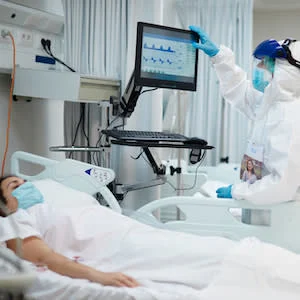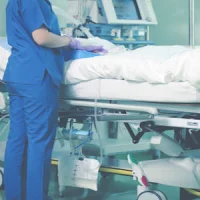There is increasing evidence supporting the use of extracorporeal membrane oxygenation (ECMO) for severe acute respiratory distress syndrome (ARDS) in patients that do not respond to maximal medical therapy. ARDS can occur in some COVID-19 patients who are hospitalised, and ECMO can be utilised as a treatment option in some cases. Using ECMO can help avoid ventilator-induced lung injury and give the lungs time to rest while waiting for recovery. The mortality rate of ARDS related to COVID-19 has been assessed and reassessed during the pandemic. Veno-venous (VV) ECMO has been commonly used as the primary treatment option for managing refractory respiratory failure. However, when there is severe right ventricular dysfunction, alternatives such as venoarterial (VA) ECMO or mechanical right ventricular assist devices with extracorporeal gas exchange (Oxy-RVAD) may be considered. A recent review summarises the latest evidence on the use of ECMO in different patient populations with COVID-19-related ARDS.
The clinical presentation of COVID-19 can vary widely, from no symptoms at all to severe ARDS) which can potentially be fatal. In a small number of cases, COVID-19 can also cause myocardial inflammation, such as myocarditis, and lead to cardiogenic shock. ARDS is characterised by an increase in anatomical shunt and a reduction of functioning lung size. These factors contribute to high respiratory system elastance. In these patients, increasing lung size is often accomplished by recruiting previously collapsed lung units or maintaining their patency. This is typically done by using moderate to high positive end-expiratory pressure (PEEP) levels, prone positioning, and lung recruitment manoeuvres. In patients with COVID-19-ARDS, hypoxaemia can be attributed to an increase in the physiologic shunt resulting from the loss of hypoxic pulmonary vasoconstriction and an increase in dead space fraction due to the development of pulmonary vascular microthrombi.
ECMO is used to treat severe respiratory and/or cardiac failure cases that are not responsive to optimal conventional management. Typically, veno-venous (VV) ECMO is used to manage severe respiratory failure, while venoarterial (VA) ECMO is used to manage severe cardiac failure. VV-ECMO involves draining deoxygenated blood from a central vein and pumping it through a membrane lung, where gas exchange occurs. The oxygenated blood is reinfused back into the venous system. Patients who present with both respiratory failure and right ventricular dysfunction may require VA-ECMO or a combination of VV and VA-ECMO.
The Conventional ventilatory support versus Extracorporeal membrane oxygenation for Severe Adult Respiratory failure (CESAR) trial provided evidence suggesting that the use of ECMO in patients with acute hypoxaemic respiratory failure was likely to be beneficial compared to conventional ventilatory support. The EOLIA trial was designed to determine the role of ECMO in managing severe ARDS. Patients were randomised to either receive ECMO or standard care. The trial was stopped for futility, but a post hoc analysis suggested a survival benefit with the use of ECMO, despite reporting a non-significant 11% absolute difference in 60-day mortality.
While preliminary reports on the use of ECMO for patients with COVID-19-related ARDS showed poor outcomes, larger studies using data from international registries and cohort studies suggest that ECMO outcomes are similar for both COVID-19 and non-COVID-19-related ARDS patients. Some studies from mid-2020 reported higher mortality associated with the use of ECMO in COVID-19 patients, which has led to concerns about appropriate patient selection for this therapy. Studies reported higher mortality with the use of ECMO for COVID-19 from mid-2020, which could be explained by several factors, including prolonged use of non-invasive respiratory support before endotracheal intubation, more liberal ECMO use, bacterial superinfections due to COVID-19 immunosuppressive treatments, and the use of ECMO in less experienced centers. The use of ECMO for COVID-19-related ARDS was associated with a higher number of thrombotic complications in the extracorporeal circuit than in non-COVID-19-related ARDS. Anticoagulation management is complex during ECMO and requires special attention in COVID-19 patients with a greater risk of thrombosis.
Three recent trials (Shaefi et al., Hajage et al., and Luyt et al.) were conducted to evaluate the effectiveness of ECMO compared to conventional mechanical ventilation in patients with severe COVID-19-related ARDS. Shaefi et al. and Hajage et al. observed a reduction in 60-day hospital mortality associated with ECMO in patients with severe hypoxaemia, while Luyt et al. found no significant difference in mortality between the two groups. However, patients in the ECMO group had a higher rate of bleeding and thrombotic complications. The COVID-19 Critical Care Consortium Investigators conducted a larger emulated target trial. The study showed that patients with severe hypoxaemia supported with ECMO had lower 60-day mortality than those managed only with mechanical ventilation.
ECMO is an established treatment for acute respiratory failure and has been used for COVID-19-related ARDS, although patients with COVID-19 may have worse outcomes. Targeted trials have shown that ECMO can benefit selected patients with severe COVID-19-related ARDS, particularly those with severe hypoxaemia and those receiving high-intensity mechanical ventilation.
Source: Journal of Intensive Care
Image Credit: iStock
References:
Alessandri F, Di Nardo M, Ramanathan K et al. (2023) Extracorporeal membrane oxygenation for COVID-19-related acute respiratory distress syndrome: a narrative review. Journal of Intensive Care. 11:5.
Latest Articles
ECMO, acute respiratory distress syndrome, ARDS, Extracorporeal Membrane Oxygenation, COVID-19, COVID-19-ARDS
ECMO for COVID-19 ARDS










